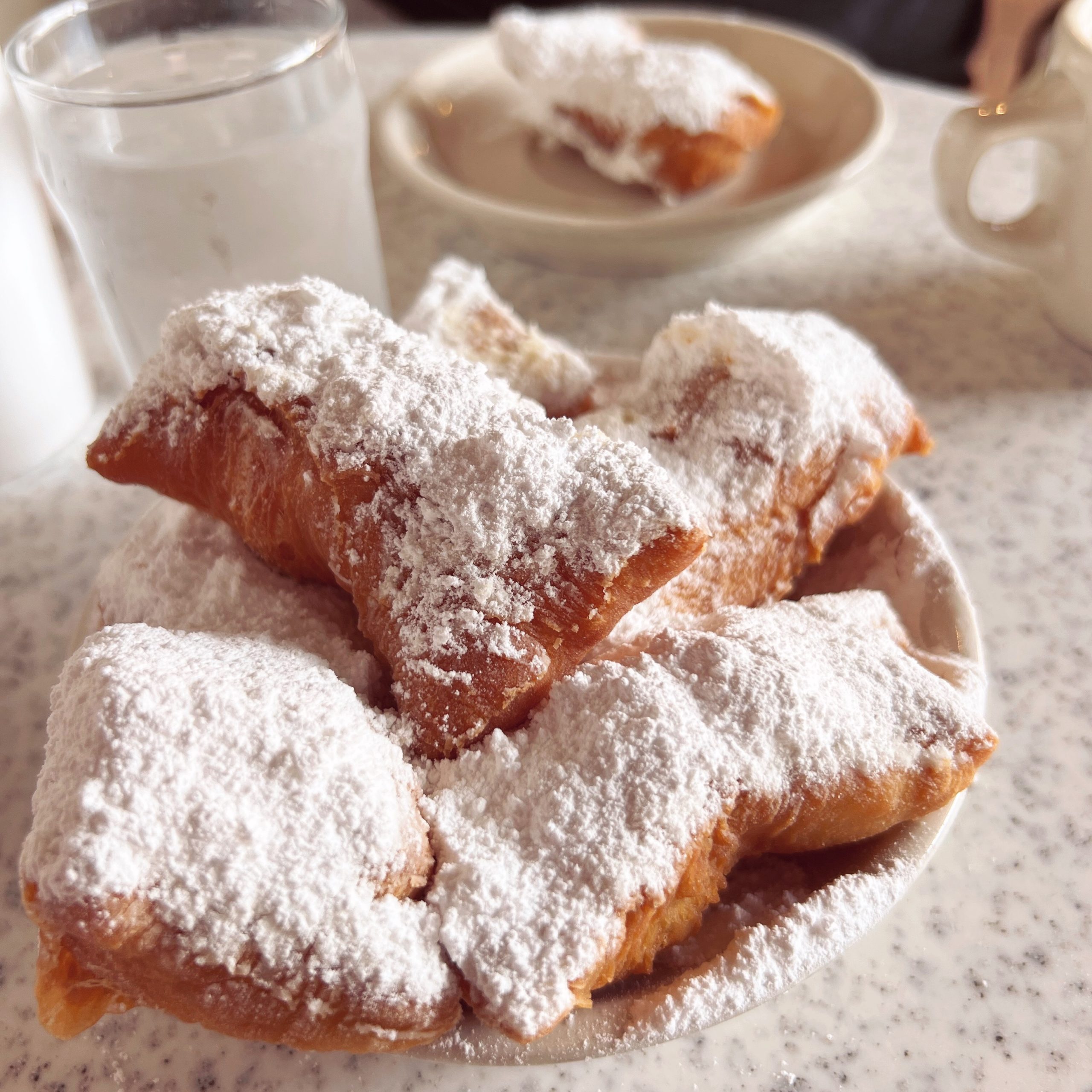
I recently attended the 2022 World Fantasy Convention in New Orleans. On the last day of the convention, after listening to a panel on Food in Fantasy, my friend and I hopped on a street car for the short trip to the French Quarter and Jackson Square, where we indulged ourselves (for the second time) with one of New Orleans’ sweetest culinary treasures1 — beignets from Cafe de Monde.
It’s not often that a tourist favorite lives up to the hype, but these beignet absolutely do. Thick and chewy on the inside, crisp and golden on the outside, the pastries are served up warm under a blanket of powdered sugar that melts in your mouth like icing. They are messy to eat, but that’s part of the pleasure of the treat, the absolute decadence as you abandon table manners and send clouds of white sugar poofing over your lips, your blouse, the table, the floor. And because everyone around you is enjoying the same sweet challenge, there’s no self-consciousness about the messy consequences.
I have had plenty of fried dough before — I think every cultural cuisine has some kind of fried dough dish — but never something quite like the Cafe de Monde beignets. While I had lots of other great food and great memories in New Orleans, it’s the beignets that I will think of first when I think of that trip.
Food is like that. It embeds itself in our daily experiences, creating powerful associations with taste and aromas that can trigger an emotional response, whether its a fond memory, a bad feeling or even just hunger. I will always think of the renaissance faire when I smell cinnamon rolls, because the first time I went to a faire, the very first food booth we passed sold them and the air was redolent with their fresh-baked scent.
Food is such an ordinary, everyday thing that we often overlook how useful it can be in storytelling. Very often, we’re so caught up in plot points and character arcs that we don’t think about when or how or what the people in our stories are eating. I get it — eating is ordinary and potentially boring. But the universality of having to eat means that it becomes an ideal tool for showing the unique (pardon the pun) flavor of your world and your characters.
Here are four ways you can use food within your storytelling to enhance your story and give it some extra spice (sorry not sorry).
Food as World Building
Food is one of the foundational elements of world building, because so much of everyday life is wound up in the accumulation of food, the preparation of food, and the consumption of food. When you are designing a fantasy setting, one of the first things you should think about what kinds of food the inhabitants grow, gather or hunt. Even if your characters aren’t involved in those activities (if they live in a city, for example) what they eat will be influenced by the region, so you might have to do a little research to figure that out what sort of crops and herds are suitable for the local environment.
After you know what varieties of food and drink are available, you can start building the food culture. Who prepares food? Are there dietary restrictions? Are there rituals surrounding cooking and eating? What kinds of utensils and dishware do people use? Are recipes simple or complex, generally the same or specific to clans, families and individuals? Do restaurants exist, or do people mostly eat at home? What do people eat when they are traveling? Is the food generally spicy or sour or sweet or bland? What flavor most characterizes local cuisine?
Next, you can ask yourself how food has shaped history and economics. How common is famine, and what happens when there’s a food shortage? What foods have to be traded for? What are the routes that people travel to trade food? If people buy food, what does a market look like? What kind of food preservations techniques are common?
In SFF, you can be as realistic or as fanciful as you wish with these ideas — some species of fairies only drink morning dew gathered in the cups of daffodil blossoms, after all — but sprinkling these details through your story will make your invented world will give it depth and texture.2
Food as Character Building
Everybody eats. What and how a character eats, though, can tell you a great deal about that person. For example, if I tell you that my protagonist drinks three cups of coffee before nine a.m., you’ll probably guess that they’re overtired and maybe a little edgy. Someone who packs a lunch of a turkey sandwich and carrot sticks every day is watching their weight or their wallet. Whether a family eats together at the table every night or sitting alone in front of the tv starts to build a picture of what that family is like.
How much time does your character spend thinking about food, and is that related to the general scarcity or abundance of food? Do they spend all or part of their time acquiring or preparing food? Are they hungry frequently? Do they worry about other people being hungry and fed? Do they enjoy food? Do they lick their fingers? Do they find crumbs in their mustache two hours after finishing a meal?
This doesn’t even get into eating disorders, which is a whole different level of characterization that involves food. But even if you don’t go that far, There are countless ways you can use food as a tool to reveal things about your characters, and because food (or the lack of it) is omnipresent in our lives, you don’t have to go far out of your way to find an excuse to include it.
Food as Emotion
Of all the ways that food can enhance your story, the emotional level is probably the most subtle. As I said before, food carries strong emotional associations, and you can play with that notion to create an emotional response in your readers.
You can do this directly through your characters, by exploring their own reactions and associations with food, either casually and in passing or in moments of high drama — the notorious moment when food turns to ash in someone’s mouth when they hear bad news, for example.
You can also manipulate the readers indirectly by describing foods or smells in a way that is so vivid it creates an emotional reaction — usually desire (the “now I’m hungry” response) but also revulsion (imagine every Klingon dish you’ve seen) . These second-hand reactions contribute to the mood and atmosphere of a scene, helping to create a lasting impression. Chicken soup is homey, sculpted meringues are regal, moldy bread is pitiful. Use the power of food to create a deeper emotional level for your story that builds on the reader’s own experience.
Food as Action
Kitchens, dining tables, restaurants and coffee shops — or, if we’re talking fantasy literature, taverns, campfires and mead halls — provide a backdrop for countless scenes of drama. A lot of fiction involves people simply talking to one another, and sometimes those conversations can get pretty long. In order to avoid the problem of talking heads3 you need to give them something to do while they’re exchanging words.
Since cooking and eating are such common activities, it makes sense to use them as a backdrop for the important scenes of dialog that need to take place. A mom stirs the soup pot while her daughter argues with her about being forced to marry the boy from the next farm. Two friends pick out fruit from a market stall while one tells the other about the temple he wants to rob. A wise old woman pours a cup of tea for her neighbor who has come to ask for a potion.
The best part about using cooking and eating as scene backdrops is that it gives you an excuse to drop in all those world building and character details that you’ve built into your story in an organic way, without derailing the forward momentum of the story. Readers will absorb all the delicious details while finding out what happens next.
Food is an important part of our everyday lives, and it should be a part of your story too. You don’t have to turn your novel into a recipe book, but it’s well worth the effort to add a little sensory seasoning to your fantasy world.
What books have you read that include memorable foods and drinks? Are there other ways you can think of to include food in your narrative? What’s your favorite kind of fried dough? Share your thoughts in the comments!
